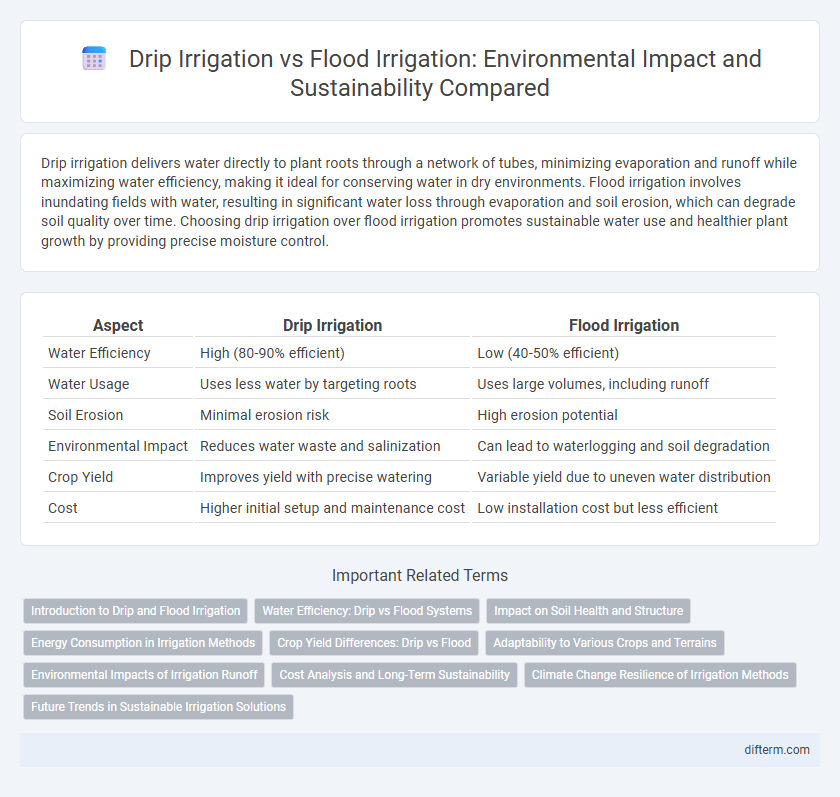Drip irrigation delivers water directly to plant roots through a network of tubes, minimizing evaporation and runoff while maximizing water efficiency, making it ideal for conserving water in dry environments. Flood irrigation involves inundating fields with water, resulting in significant water loss through evaporation and soil erosion, which can degrade soil quality over time. Choosing drip irrigation over flood irrigation promotes sustainable water use and healthier plant growth by providing precise moisture control.
Table of Comparison
| Aspect | Drip Irrigation | Flood Irrigation |
|---|---|---|
| Water Efficiency | High (80-90% efficient) | Low (40-50% efficient) |
| Water Usage | Uses less water by targeting roots | Uses large volumes, including runoff |
| Soil Erosion | Minimal erosion risk | High erosion potential |
| Environmental Impact | Reduces water waste and salinization | Can lead to waterlogging and soil degradation |
| Crop Yield | Improves yield with precise watering | Variable yield due to uneven water distribution |
| Cost | Higher initial setup and maintenance cost | Low installation cost but less efficient |
Introduction to Drip and Flood Irrigation
Drip irrigation delivers water directly to plant roots through a network of valves, pipes, and emitters, maximizing water efficiency and reducing evaporation. Flood irrigation involves inundating fields with water, often resulting in higher water use and increased runoff. Both methods impact water conservation and crop yields differently in agricultural water management.
Water Efficiency: Drip vs Flood Systems
Drip irrigation delivers water directly to plant roots through a network of tubes and emitters, reducing water loss due to evaporation and runoff significantly compared to flood irrigation. Flood irrigation involves saturating soil surfaces, often leading to excessive water usage and inefficient distribution, making it less water-efficient in arid and semi-arid regions. Studies indicate that drip irrigation can save up to 50-70% more water than traditional flood methods, promoting sustainable water management in agriculture.
Impact on Soil Health and Structure
Drip irrigation enhances soil health by delivering water directly to the root zone, reducing soil erosion and nutrient leaching while maintaining optimal moisture levels that promote microbial activity. Flood irrigation often leads to soil compaction, waterlogging, and increased salinity, which degrade soil structure and reduce aeration essential for healthy root growth. Efficient water use in drip irrigation supports sustainable soil management and long-term agricultural productivity.
Energy Consumption in Irrigation Methods
Drip irrigation consumes significantly less energy compared to flood irrigation by delivering water directly to plant roots, reducing the need for large-scale water pumping and minimizing runoff. Flood irrigation requires extensive water volumes, increasing energy demand for water extraction, conveyance, and distribution across fields. Optimizing irrigation systems with drip technology leads to substantial energy savings and lower greenhouse gas emissions in agricultural practices.
Crop Yield Differences: Drip vs Flood
Drip irrigation delivers water directly to plant roots, enhancing water efficiency and increasing crop yields by up to 50% compared to flood irrigation. Flood irrigation often results in water wastage and uneven distribution, which can reduce crop productivity and increase soil erosion risks. Studies show crops grown with drip irrigation exhibit better growth uniformity and higher resistance to drought stress than those using flood irrigation methods.
Adaptability to Various Crops and Terrains
Drip irrigation demonstrates superior adaptability to various crops and terrains by delivering water directly to the root zone, minimizing water wastage and optimizing growth for diverse plant types including row crops, orchards, and vineyards. Flood irrigation, while simpler and cost-effective for flat, uniform fields with water-intensive crops such as rice, struggles on uneven terrains and with crops requiring precise moisture control. The precision and versatility of drip irrigation systems promote sustainable water management across heterogeneous agricultural landscapes.
Environmental Impacts of Irrigation Runoff
Drip irrigation significantly reduces irrigation runoff by delivering water directly to plant roots, minimizing soil erosion and nutrient leaching compared to flood irrigation. Flood irrigation often causes excessive runoff that carries fertilizers and pesticides into nearby water bodies, leading to eutrophication and habitat degradation. Efficient water use in drip systems lowers groundwater contamination risks and helps preserve aquatic ecosystems by reducing the volume and pollutant load of irrigation runoff.
Cost Analysis and Long-Term Sustainability
Drip irrigation significantly reduces water usage compared to flood irrigation, leading to lower water bills and energy costs over time. Though initial setup costs for drip irrigation systems are higher, their efficiency promotes long-term sustainability by minimizing water wastage and soil erosion. Flood irrigation, while less expensive initially, often incurs higher operational costs due to water loss and can degrade soil health, impacting crop yields and long-term profitability.
Climate Change Resilience of Irrigation Methods
Drip irrigation significantly enhances climate change resilience by minimizing water waste and reducing soil erosion compared to flood irrigation, which often leads to waterlogging and nutrient runoff. This efficient water delivery system adapts better to unpredictable rainfall patterns and extended droughts caused by climate change, ensuring sustainable crop yields. By conserving water and maintaining soil health, drip irrigation supports long-term agricultural productivity under shifting climatic conditions.
Future Trends in Sustainable Irrigation Solutions
Drip irrigation, known for its water efficiency and precision, is rapidly advancing with smart sensors and AI-driven monitoring to optimize water use and reduce waste. Flood irrigation, though traditional, is evolving through innovations like controlled flooding and water recycling systems to minimize environmental impact. Future trends emphasize integrating IoT technology and renewable energy sources to enhance sustainability and resilience in irrigation practices.
Drip irrigation vs Flood irrigation Infographic

 difterm.com
difterm.com